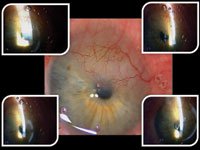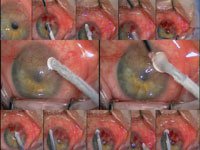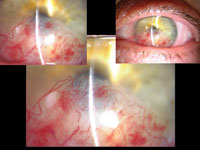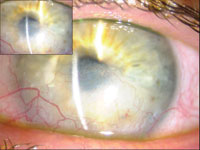Cryotherapy offers transplantation alternative for extensive neovascularization, thin corneas
The procedure is especially useful in cases of thinning in the peripheral regions of the cornea.
Corneal neovascularization involving the central cornea can contribute to visual compromise, requiring possible surgical intervention to improve corneal clarity and visual acuity. Further, corneal neovascularization can contribute to vascular leakage that can result in corneal lipid keratopathy, intrastromal inflammation, corneal scarring and possible corneal thinning. In some cases, corneal neovascularization is a potentially blinding condition.
Lamellar corneal transplantation usually requires partial stromal involvement, with the deeper corneal layers being uninvolved by corneal scar. Full-thickness corneal transplantation may not be a good surgical option in the presence of extensive corneal stromal thinning of the peripheral cornea where the donor cornea is sutured to the recipient cornea. The mismatch in thickness between the donor and recipient corneas renders these cases unsuitable for penetrating keratoplasty.
Various treatments have been utilized to manage corneal neovascularization, including anti-VEGF such as subconjunctival bevacizumab, photodynamic therapy with verteporfin, polysaccharide extract from Spirulina platensis, amniotic membrane extract, subconjunctival triamcinolone acetonide, nonsteroidal anti-inflammatory agents and cyclosporine. Surgical interventions may include the use of laser photocoagulation, electrocautery or diathermy treatment, lamellar keratoplasty and, rarely, PK.
In this column, I describe the use of corneal cryotherapy for the treatment of extensive corneal neovascularization contributing to visual compromise. Clinical studies with longer follow-up periods are warranted to further evaluate the efficacy and overall safety of this relatively simple surgical procedure. To the best of my knowledge, this is the first surgical use of cryotherapy on the central aspect of a human cornea with neovascularization and tissue invasion.
Case history
A 54-year-old Caucasian woman was referred by her ophthalmologist with extensive corneal neovascularization, corneal scarring and a fleshy-appearing growth involving the central cornea, including the visual axis (Figures 1 and 2). Slit lamp photography showed significant corneal thinning in the inferior half of the cornea. Optical coherence tomography confirmed corneal thinning (Figure 3).

Figure 1. Clinical photograph of extensive inferior corneal neovascularization extending to the central cornea and involving the visual axis (inset: higher magnification of corneal neovascularization).

Figure 2. Slit lamp photograph displaying significant corneal thinning in the inferior half of the cornea. The sheet of corneal neovascularization involves central cornea.
Images: John T

Figure 3. Corneal OCT shows inferior corneal thinning. The total thickness of 430 µm includes the thickness of the corneal growth.
Lamellar corneal transplantation was not an option due to areas of full-thickness corneal scarring in the inferior half of the cornea. PK was not optimal due to the extensive corneal thinning inferiorly in the peripheral cornea that would limit proper support to the peripheral region of a full-thickness donor corneal graft. Surgical treatment could include a two-step procedure — namely, a lamellar graft to increase the corneal thickness, followed by full-thickness PK — or both surgical treatments combined into a single procedure. Instead, a simple single-step cryotherapy of the cornea was elected.
Surgical technique
Under topical anesthesia and monitored anesthesia care, cryotherapy was applied to the involved regions of the cornea (Figure 4), and 2% lidocaine jelly was applied to the corneal surface. Application of a single freeze-thaw cycle was used to treat the corneal neovascularization, including the regions of the central cornea and the visual axis (Figure 5). Care was taken not to treat any area of the clear, uninvolved cornea. Sterile balanced salt solution was used to irrigate the corneal surface as needed. A corticosteroid drop and an antibiotic drop were applied to the corneal surface, and TobraDex ST (tobramycin/dexamethasone ophthalmic suspension 0.3/0.05%, Alcon) was applied, followed by a patch.

Figure 4. Main figure (surgeon’s view) shows extensive inferior corneal neovascularization, with fleshy, thick pannus extending to central cornea and involving the visual axis (insets: slit lamp views of the fleshy growth involving the central and inferior half of the cornea).

Figure 5. A single freeze-thaw application of cryotherapy over the involved portions of the cornea. Corneal hemorrhages are noted immediately following the cryotherapy.

Figure 6. Day 1 postop slit-lamp views showing scattered hemorrhages with an absence of active blood flow clinically.

Figure 7. Three weeks after corneal cryotherapy, vision improved from 20/100 to 20/60, and pinhole to 20/40+2. IOP was 15 mm Hg. Notice nearly complete resolution of the central corneal vasculature, with flattening of the corneal growth and increased visibility of the iris details (inset: higher magnification of the region).
On the first day after the corneal cryotherapy, there were patchy areas of corneal hemorrhage (Figure 6). At 3 weeks postop, uncorrected visual acuity improved from 20/100 to 20/60, and pinhole to 20/40+2. IOP remained normal: 15 mm Hg at 3 weeks postop. There was nearly complete resolution of the central corneal vasculature contributing to ghost vessel formation, with flattening of the corneal growth and increased visibility of the iris details (Figure 7). Clinically, there was no active, corneal blood flow. At 2 months postop there was further regression of the vascular fields. There was no active corneal blood flow in any area of the involved central and inferior cornea, and no recurrence of corneal neovascularization at 3.5 months postop.
Advantages of corneal cryotherapy
Corneal cryotherapy may be a simple surgical option to consider in cases of extensive corneal neovascularization, corneal scarring and significant corneal thinning, especially in the peripheral regions of the cornea that would otherwise require more complex surgical intervention for visual rehabilitation.
Cryotherapy was used in all regions of the involved cornea, including the visual axis. The goal is to treat only the superficial and intrastromal corneal neovascularization, and hence only a single freeze-thaw cycle is required and there is no need for the usual double freeze-thaw cycle that is used in treating ocular surface neoplasia.
Although this procedure may cause some degree of corneal endothelial cell damage, there was no clinically detectable corneal edema in any of the treated or untreated areas of the cornea during the entire postoperative follow-up of 3.5 months. Regression of the corneal neovascularization contributed to flattening of the corneal growth, increased corneal transparency, and improved postop visual acuity. The patient was pleased with the procedure and required no further surgical intervention.
Single-cycle freeze-thaw corneal cryotherapy may be considered as a less invasive corneal surgical treatment in cases of significant corneal neovascularization.
References:
- Al-Torbak AA. Photodynamic therapy with verteporfin for corneal neovascularization. Middle East Afr J Ophthalmol. 2012;19(2):185-189.
- Bahar I, Yeung SN, Sella R, Slomovic A. Anterior segment uses of bevacizumab. Curr Opin Ophthalmol. 2012;23(4):303-316.
- Papathanassiou M, Theodoropoulou S, Analitis A, Tzonou A, Theodossiadis PG. Vascular endothelial growth factor inhibitors for treatment of corneal neovascularization: A meta-analysis [published online ahead of print June 4, 2012]. Cornea. doi:10.1097/ICO.0b013e3182542613.
- Stevenson W, Cheng SF, Dastjerdi MH, Ferrari G, Dana R. Corneal neovascularization and the utility of topical VEGF inhibition: ranibizumab (Lucentis) vs bevacizumab (Avastin). Ocul Surf. 2012;10(2):67-83.
- Yang LL, Zhou QJ, Wang Y, Gao Y, Wang YQ. Comparison of the therapeutic effects of extracts from Spirulina platensis and amnion membrane on inflammation-associated corneal neovascularization. Int J Ophthalmol. 2012;5(1):32-37.
For more information:
- Thomas John, MD, is a clinical associate professor at Loyola University at Chicago and in private practice in Oak Brook, Tinley Park and Oak Lawn, Ill. He can be reached at 708-429-2223; fax: 708-429-2226; email: tjcornea@gmail.com.
- Disclosure: Dr. John has no relevant financial disclosures.
